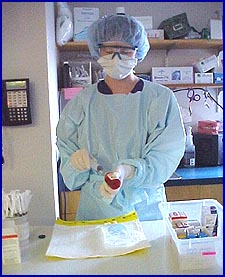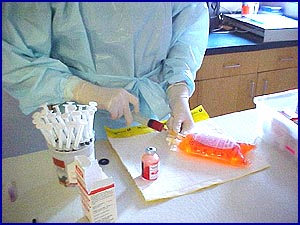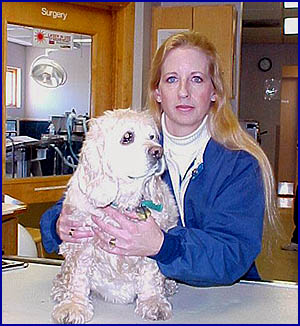|
Cancer in Pets
  
|
Cells naturally divide and increase in numbers in a process called mitosis. Normal cells divide to replace those lost or injured and then stop. Cancer cells are abnormal in that they continuously multiply uncontrollably, and may grow into adjacent tissues or spread to distant parts of the body. The accumulation of these cells eventually become large enough to produce lumps, masses, or tumors that can be detected. The tumor can be benign or malignant. Benign tumors are not cancerous and can usually be removed. The majority of these do not return, nor do they spread to other parts of the body. Malignant tumors are cancerous. They can also be removed but can invade nearby tissues and organs and can metastasize. Metastasis is when the cells break away from the tumor and enter the bloodstream or lymphatic system to form secondary tumors at different locations. *** It is important to realize that if your pet has been diagnosed with some form of malignant cancer, it does not necessarily mean the end of his or her life. Many pets can be cured or go into remission for months or years.Once we have a complete understanding of your pet's health and type of cancer, we can design an appropriate treatment plan.
|
Cancer Therapy
Cancer therapy in pets includes surgery, chemotherapy and radiation therapy. One or a combination of these treatments may be used and is tailored to your pet individually. Whether a treatment or therapy is appropriate for your pet with cancer depends upon:
- The type of cancer (based upon biopsy or cytology)
- The grade or stage of cancer (how aggressive or fast moving it is)
- The location of the growth
Surgery:
Surgery may be warranted in cancer treatment for many reasons including:
- Surgery to remove or destroy cancerous tissue including the removal of some tissue around the tumor and/or nearby lymph nodes.
- Surgery to remove samples of the tissue from a suspicious area for testing and evaluation to confirm a diagnosis or identify the type of cancer.
Chemotherapy:
Chemotherapy is the use of anti-cancer drugs to treat cancerous cells. Chemotherapy is used as a treatment for non-operable cancer involving more than one part of the body or post-surgical if the cancer is one that is likely to metastasize.The goal when using chemotherapy is to control the cancer and prolong survival while still maintaining a good to excellent quality of life for the patient. It is very important to understand the difference between complete remission and a cure.CHEMOTHERAPY IS NO LONGER PERFORMED AT GEORGETOWN ANIMAL CLINIC, PC |
For example, the majority of dogs with lymphoma (a cancer of the lymphoid tissue) will enjoy a rapid and complete remission following initiation of chemotherapy. Lymphoma, however, will ultimately relapse. A cure means the cancer is totally gone and will not likely return.
Radiation Therapy:
Radiation therapy is the treatment of cancer and other diseases with ionizing radiation. Ionizing radiation deposits energy that injures or destroys cells in the area being treated (the target tissue) by damaging their genetic material making it impossible for these cells to continue to grow. Although radiation destroys both cancer cells and normal cells, the normal cells are able to repair themselves and function properly. Radiation therapy is generally used to treat localized solid tumors. Radiation therapy is performed at a facility specialized in this technique.
RADIATION THERAPY IS NOT PERFORMED AT GEORGETOWN ANIMAL CLINIC, PC
Treatment protocols for cancer is determined based upon:
- Your pets overall health and medical history
- The extent of the disease
- Expectations for the course of the disease
- AND MOST IMPORTANT, informed decision
Back to Topics of Interest
|